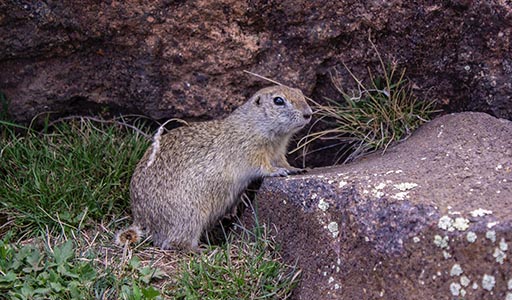Gophers

Gopher Information
Gophers are small burrowing rodents native to many parts of North and Central America. These creatures have cheek pouches where they can store nuts and other vegetation in their mouths. Unlike similar rodents, gophers do not hibernate during the winter, meaning that they are active all year wrong. Gophers create their homes inside burrows in the ground that consist of a series of tunnels. These tunnels can be used for storing food or moving from one place to another.

What does a Gopher look like?
On average, pocket gophers are small creatures that weigh about half a pound and reach around 7 inches lengthwise. They are mostly brown in color and have typical rodent characteristics like small, beady eyes, tails, and protruding incisors. Gophers also have claws, which are curved and used for digging extensive tunnel systems, while their cheek pouches allow them to hoard food.

What does a Gopher eat?
Gophers rarely leave their burrows to find food, although they do surface occasionally to eat plant bulbs, nuts, and fruits. The rodents typically prefer roots and pieces of plants that are accessible from underground, targeting crops like beets, turnips, and carrots.

Gopher habitats
Pocket gophers can live most anywhere soil is soft and easily excavated, and species are found in each region of North America. Even areas with seasonally cold climates support populations of gophers, as they adapt and burrow through snow. Gophers are rarely seen above ground. If sighted outside their tunnels, they are generally seeking food or digging new pathways. They rarely venture more than a few feet from the nearest tunnel entry.
Frequently Asked Questions
While these ground-dwelling animals are often mistaken for one another, moles and gophers are actually not all that similar. Pocket gophers are the variety most closely related to moles, and even these two pests don’t particularly look alike. There are several major differences in appearance:
- Teeth – Moles have very small teeth, while the teeth of a gopher protrude from its mouth.
- Eyes – Gophers have readily visible eyes, but a mole’s eyes can barely be seen.
- Snout – Moles have a long, tapering snout. Conversely, gophers have rounded faces and muzzles.
Since both animals spend most of their time underground, appearance might not be the best way to tell which is causing problems. Knowing the difference between gopher holes vs mole holes is quite helpful, and there are several key indicators:
- Mole tunnels make obvious ridges in the surface of a lawn.
- Piles of dirt left by moles, or molehills, are circular and have holes directly in the center.
- Gopher burrows are hard to see aboveground.
- Mounds created by gophers are shaped like crescents, hearts, or fans with holes on the side.
Diet is another way to identify which pest is living on the property. Gophers primarily consume vegetation like roots, tubers, and garden plants. On the other hand, moles mostly eat underground insects like grubs and worms.
Though they are often confused for one another, there are several differences between gophers and groundhogs. For example, gophers are small rodents weighing around two to three pounds, while groundhogs tend to be about ten pounds. Other differences include:
- Gophers have yellow teeth and groundhog incisors are white.
- Groundhogs have simple tunnels and dens, but gophers have extensive, complex burrow systems.
- In order to survive the cold weather, gophers create food stores, while groundhogs gorge themselves during the summer and hibernate over the winter.
The size and color of a gopher vs a groundhog can also identify them. Gophers are six to eight inches long and brownish-gray with hints of yellow in the fur. They have large, clawed front paws and strong hind legs. Groundhogs are stocky and 16 to 20 inches long with a four- to six-inch tail. Their coloring is typically gray to reddish-brown.


